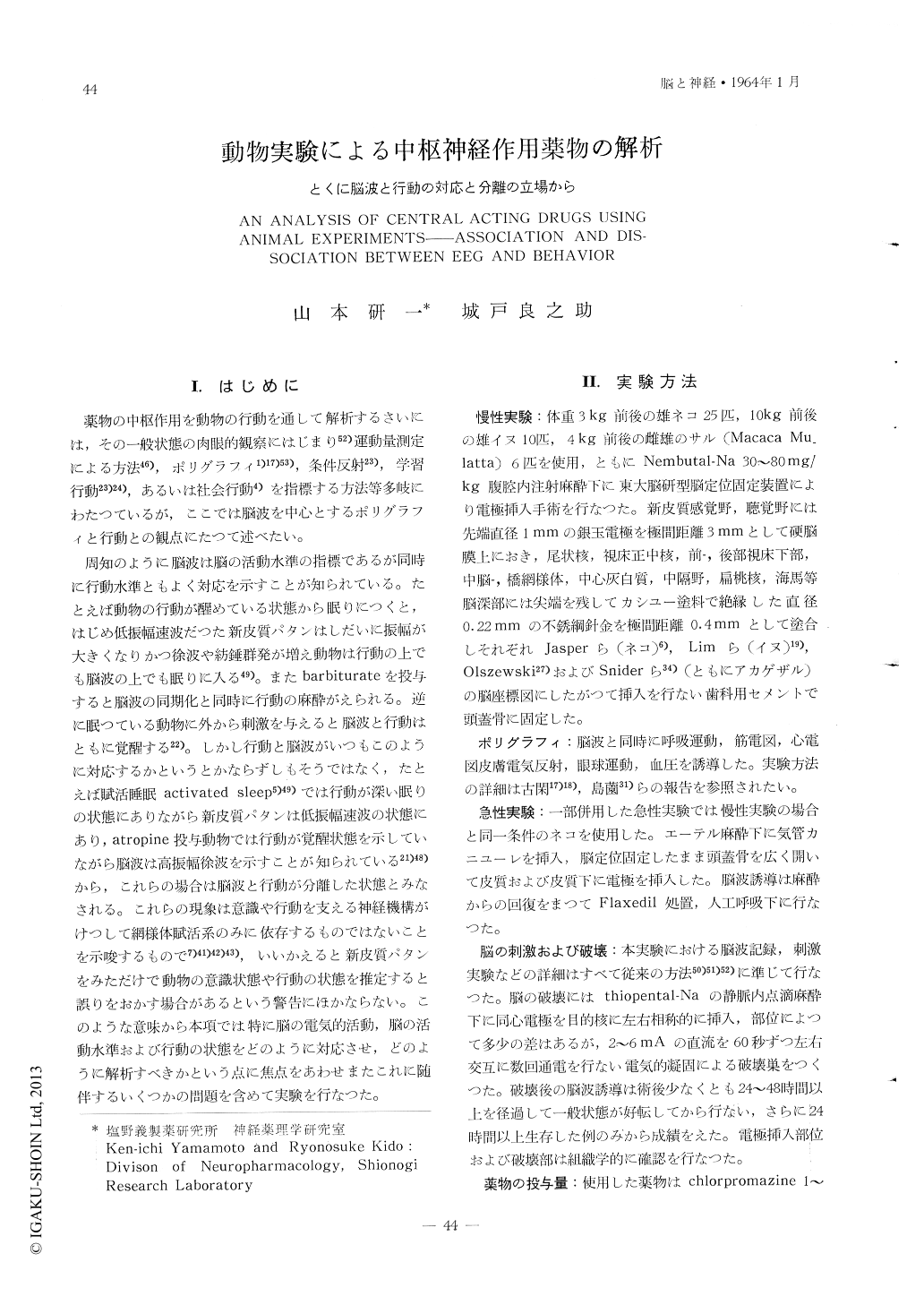Japanese
English
- 有料閲覧
- Abstract 文献概要
- 1ページ目 Look Inside
I.はじめに
薬物の中枢作用を動物の行動を通して解析するさいには,その一般状態の肉眼的観察にはじまり52)運動量測定による方法46),ポリグラフィ1)17)53),条件反射23),学習行動23)24),あるいは社会行動4)を指標する方法等多岐にわたつているが,ここでは脳波を中心とするポリグラフィと行動との観点にたつて述べたい。
周知のように脳波は脳の活動水準の指標であるが同時に行動水準ともよく対応を示すことが知られている。たとえば動物の行動が醒めている状態から眠りにつくと,はじめ低振幅速波だつた新皮質パタンはしだいに振幅が大きくなりかつ徐波や紡錘群発が増え動物は行動の上でも脳波の上でも眠りに入る49)。またbarbiturateを投与すると脳波の同期化と同時に行動の麻酔がえられる。逆に眠つている動物に外から刺激を与えると脳波と行動はともに覚醒する22)。しかし行動と脳波がいつもこのように対応するかというとかならずしもそうではなく,たとえぱ賦活睡眠activated sleep5)49)では行動が深い眠りの状態にありながら新皮質パタンは低振幅速波の状態にあり,atropine投与動物では行動が覚醒状態を示していながら脳波は高振幅徐波を示すことが知られている21)48)から,これらの場合は脳波と行動が分離した状態とみなされる。これらの現象は意識や行動を支える神経機構がけつして網様体賦活系のみに依存するものではないことを示唆するもので7)41)42)43),いいかえると新皮質パタンをみただけで動物の意識状態や行動の状態を推定すると誤りをおかす場合があるという警告にほかならない。このような意味から本項では特に脳の電気的活動,脳の活動水準および行動の状態をどのように対応させ,どのように解析すべきかという点に焦点をあわせまたこれに随伴するいくつかの間題を含めて実験を行なつた。
Electroencephalographic and behavioral ana-lysis of CNS acting drugs in cats, dogs and monkeys were described.
1) Differences of EEG patterns between acute and chronic animals: There is no essen-tial differences of the normal EEG patterns between acute and chronic animals, but deep sleep patterns and activated sleep patterns were not seen in acute animals. These dif-ferences of EEG patterns due to differences in experimental conditions were also obser-ved after administration of some CNS acting drugs. For instance, after administration of morphine slow waves and spindle bursts were continuously seen in the acute cat, while de-synchronization patterns are lasting in chro-nic animals. These findings show the danger of misunderstanding consciousness levels if only acute EEG patterns are used as the criteria for judgement.
2) Differences of electroencephalographic and behavioral responses due to species pe-culiarity of animals: After administration of reserpine, meprobamate and barbiturates, differences of EEG and behavior among cats, dogs and monkeys were not observed. How-ever, "rage-like behavior" due to administra-tion of chlorpromazine is only seen in cats. Also, after administration of morphine, cats show continuous arousal, dogs show narcosis, and monkeys show intermediate responses between cats and dogs; both in electrogra-phically and behaviorally.
3) Dissociations between EEG and beha-vior: After stimulation or the causing of lisi-ons of the mesencephalic reticular formation or the posterior hypothalamus, the same tendency is seen in the electrographical and behavioral responses. Both in activated sleep and in cases with reticular lesions at the caudal brain stem, the animal shows a sleep-like posture, while the EEG shows activation-like patterns. This dissociation between EEG and behavior is also observed after administra-tion of some CNS depressants. For example, chlorpomazine elevated the stimulation thre-shold of EEG activation both in the hypo-thalamic activating system and the central gray matter; on the contrary, sham rage and hissing caused by the same stimulations are not changed by the drugs, Also meprobamate only elevated the stimulation threshold of the reticular activating system, while sham rage and olfactory response are inhibited by the drug. Furthermore, dissociation such as seen in atropine treatment and in ether anes-thesia indicates the necessity of simultaneous observations on both EEG and behavior.
4) Polygraphy: Close relationship between EEG and periferal somato-autonomic func-tions, such as blood pressure, GSR, nictitating membrane, and EMG have been confirmed. The above results on the relationship between EEG and behavior might be shown that if we use simultaneous recording of EEG and periferal somato-autonomic activities (Poly-graphy), more precise analysis of the drug actions on the CNS might be made.

Copyright © 1964, Igaku-Shoin Ltd. All rights reserved.


